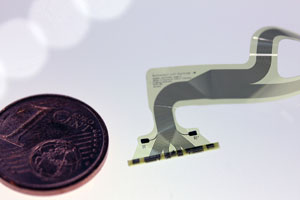Implantable Cuff with Electrodes

The cuff is equipped with electrodes that can lower blood pressure without causing side effects. Source: IMTEK
High blood pressure is the greatest health risk worldwide behind smoking and alcohol consumption. In Germany, around 25 percent of the population suffers from arterial hypertension, as the condition is referred to in medical circles. The microsystems engineers Dr. Dennis Plachta and Prof. Dr. Thomas Stieglitz from the Laboratory of Biomedical Microtechnology at the Department of Microsystems Engineering (IMTEK) of the University of Freiburg teamed up with the neurosurgeons Dr. Mortimer Gierthmühlen and Prof. Dr. Josef Zentner from the Medical Center – University of Freiburg to develop a new cuff equipped with electrodes that can lower blood pressure without causing side effects.
Doctors usually prescribe drugs against high blood pressure. In around 35 percent of patients, however, pills do not succeed in reducing blood pressure in the long term. Chronic high blood pressure leads to damage in other organs – the eyes, kidneys, the heart, and the central nervous system, in particular. In order to help patients whose blood pressure cannot be reduced by means of drugs, the Freiburg researchers propose implanting a newly developed cuff with 24 electrodes in the so-called vagal nerve on the neck. The device starts by determining which electrode is closest to the nerve fibers that transmit the blood pressure signal. Then it uses electrostimulation to overwrite the information in these fibers with such precision that other bundles of fibers with other functions are not affected. The researchers have named this procedure for individual analysis, selection, and stimulation “BaroLoopTM.”
The scientists tested the device on rats and succeeded in lowering their mean blood pressure by 30 percent, without causing side effects such as a reduced heart rate or a drastic decrease in respiratory rate. The findings of the study have been published in the Journal of Neural Engineering.
The idea for the research project originated in 2004 within the context of the establishment of the Peter Osypka Endowed Chair in Neuroelectronic Systems at the Department of Neurosurgery. Now that the scientists have determined that a cuff with electrodes is feasible in principle, they have begun to develop a completely implantable system. As such a device is classed as an active implant that must fulfill the highest level of safety standards according to medical product laws, they do not expect to produce a licensed product for at least ten years.
Original publication:
“Blood pressure control with selective vagal nerve stimulation and minimal side effects” (D T T Plachta et al. 2014 Journal of Neural Engineering 11 036011).
Contact:
Dr. Dennis Plachta and Prof. Dr. Thomas Stieglitz
Laboratory of Biomedical Microtechnology
Department of Microsystems Engineering
Phone: +49 (0)761/203-7456 / -7371
E-Mail: plachta@imtek.uni-freiburg.de; thomas.stieglitz@imtek.uni-freiburg.de
Natascha Thoma-Widmann
PR/Marketing Officer
Faculty of Engineering
University of Freiburg
Phone: +49 (0)761/203-8056
E-Mail: thoma-widmann@tf.uni-freiburg.de
Media Contact
All latest news from the category: Medical Engineering
The development of medical equipment, products and technical procedures is characterized by high research and development costs in a variety of fields related to the study of human medicine.
innovations-report provides informative and stimulating reports and articles on topics ranging from imaging processes, cell and tissue techniques, optical techniques, implants, orthopedic aids, clinical and medical office equipment, dialysis systems and x-ray/radiation monitoring devices to endoscopy, ultrasound, surgical techniques, and dental materials.
Newest articles

Combatting disruptive ‘noise’ in quantum communication
In a significant milestone for quantum communication technology, an experiment has demonstrated how networks can be leveraged to combat disruptive ‘noise’ in quantum communications. The international effort led by researchers…

Stretchable quantum dot display
Intrinsically stretchable quantum dot-based light-emitting diodes achieved record-breaking performance. A team of South Korean scientists led by Professor KIM Dae-Hyeong of the Center for Nanoparticle Research within the Institute for…

Internet can achieve quantum speed with light saved as sound
Researchers at the University of Copenhagen’s Niels Bohr Institute have developed a new way to create quantum memory: A small drum can store data sent with light in its sonic…





















